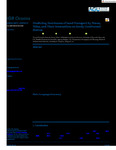Predicting Dominance of Sand Transport by Waves, Tides, and Their Interactions on Sandy Continental Shelves
| dc.contributor.author | King, EV | |
| dc.contributor.author | Conley, Daniel | |
| dc.contributor.author | Masselink, Gerd | |
| dc.contributor.author | Leonardi, N | |
| dc.date.accessioned | 2021-10-18T13:22:48Z | |
| dc.date.available | 2021-10-18T13:22:48Z | |
| dc.date.issued | 2021-09 | |
| dc.identifier.issn | 2169-9275 | |
| dc.identifier.issn | 2169-9291 | |
| dc.identifier.other | e2021JC017200 | |
| dc.identifier.uri | http://hdl.handle.net/10026.1/18089 | |
| dc.description.abstract |
<jats:title>Abstract</jats:title><jats:p>Waves and tidal currents resuspend and transport shelf sediments, influencing sediment distributions and bedform morphology with implications for various disciplines including benthic habitats, marine operations, and marine spatial planning. Shelf‐scale assessments of wave‐tide‐dominance of sand transport tend not to fully include wave‐tide interactions, which nonlinearly enhance bed shear stress and apparent roughness, change the current profile, modulate wave forcing, and can dominate net sand transport. Assessment of the contribution of wave‐tide interactions to net sand transport requires computationally/labor intensive coupled numerical modeling, making comparison between regions or climate conditions challenging. Using the Northwest European Shelf, we show the dominant forcing mode and potential magnitude of net sand transport is predictable from readily available, uncoupled wave, tide, and morphological data in a computationally efficient manner using a k‐Nearest Neighbor algorithm. Shelf areas exhibit different dominant forcing modes for similar wave exceedance conditions, related to differences in depth, grain size, tide range, and wave exposure. Wave‐tide interactions dominate across most areas in energetic combined conditions. Meso‐macrotidal areas exhibit tide‐dominance while shallow, fine‐grained, microtidal regions show wave‐dominance over a statistically representative year, with wave‐tide interactions dominating extensively >30 m depth. Sediment transport mode strongly affects seabed morphology. Sand wave geometry varies significantly between predicted dominance classes with increased wave length and asymmetry, and decreased height, for increasing wave‐dominance. This approach efficiently indicates where simple noninteractive wave and tide processes may be sufficient for modeling sediment transport, and enables efficient interregional comparisons and sensitivity testing to changing climate conditions with applications globally.</jats:p> | |
| dc.language | en | |
| dc.language.iso | en | |
| dc.publisher | American Geophysical Union | |
| dc.relation.uri | http://hdl.handle.net/10026.1/17601 | |
| dc.subject | classification scheme | |
| dc.subject | continental shelf | |
| dc.subject | k-nearest neighbor | |
| dc.subject | sand transport | |
| dc.subject | sand waves | |
| dc.subject | sediment transport | |
| dc.subject | wave-current interaction | |
| dc.title | Predicting Dominance of Sand Transport by Waves, Tides, and Their Interactions on Sandy Continental Shelves | |
| dc.type | journal-article | |
| dc.type | Journal Article | |
| plymouth.author-url | https://www.webofscience.com/api/gateway?GWVersion=2&SrcApp=PARTNER_APP&SrcAuth=LinksAMR&KeyUT=WOS:000702389500022&DestLinkType=FullRecord&DestApp=ALL_WOS&UsrCustomerID=11bb513d99f797142bcfeffcc58ea008 | |
| plymouth.issue | 9 | |
| plymouth.volume | 126 | |
| plymouth.publication-status | Published | |
| plymouth.journal | Journal of Geophysical Research: Oceans | |
| dc.identifier.doi | 10.1029/2021jc017200 | |
| plymouth.organisational-group | /Plymouth | |
| plymouth.organisational-group | /Plymouth/Faculty of Science and Engineering | |
| plymouth.organisational-group | /Plymouth/Faculty of Science and Engineering/School of Biological and Marine Sciences | |
| plymouth.organisational-group | /Plymouth/PRIMaRE Publications | |
| plymouth.organisational-group | /Plymouth/REF 2021 Researchers by UoA | |
| plymouth.organisational-group | /Plymouth/REF 2021 Researchers by UoA/UoA07 Earth Systems and Environmental Sciences | |
| plymouth.organisational-group | /Plymouth/Research Groups | |
| plymouth.organisational-group | /Plymouth/Research Groups/Marine Institute | |
| plymouth.organisational-group | /Plymouth/Users by role | |
| plymouth.organisational-group | /Plymouth/Users by role/Academics | |
| plymouth.organisational-group | /Plymouth/Users by role/Researchers in ResearchFish submission | |
| dcterms.dateAccepted | 2021-08-01 | |
| dc.rights.embargodate | 2021-12-3 | |
| dc.identifier.eissn | 2169-9291 | |
| dc.rights.embargoperiod | Not known | |
| rioxxterms.versionofrecord | 10.1029/2021jc017200 | |
| rioxxterms.licenseref.uri | http://www.rioxx.net/licenses/all-rights-reserved | |
| rioxxterms.licenseref.startdate | 2021-09 | |
| rioxxterms.type | Journal Article/Review | |
| plymouth.funder | Physical and biological dynamic coastal processes and their role in coastal recovery (BLUE-coast)::NERC |


